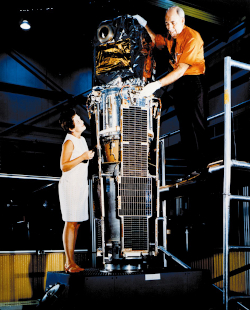HEAPOW: The First Orbiting X-ray Astronomy Facility (2023 Jan 16)
Posted: Tue Jan 31, 2023 6:01 pm
 The First Orbiting X-ray Astronomy Facility
The First Orbiting X-ray Astronomy Facility
The discovery of the first X-ray sources outside the solar system in 1962 generated great interest in the high-energy sky. What could produce such powerful radiation, and how many other X-ray sources populate the sky? To answer these fundamental questions, a dedicated X-ray observing facility was needed, in orbit above the blocking effect of earth's atmosphere. The first NASA satellite mission dedicated to exploring the X-ray sky was the X-ray Explorer Satellite, SAS-A (for Small Astronomy Satellite A). SAS-A was launched from a platform off the coast of Kenya on December 12, 1970. This was the seventh anniversary of the independence of Kenya, and the satellite was renamed Uhuru, which means "freedom" in Swahili, in honor of this anniversary. The observatory is pictured above, along with Marjorie Townsend, NASA's project manager for the Small Astronomy Satellite program (notably, the first woman to receive an engineering degree from The George Washington University), along with Bruno Rossi, an MIT physicist and one of the founders of the field of X-ray astrophysics. Uhuru produced the first catalog of X-ray sources, containing 339 individual X-ray emitting objects (now we know many millions of X-ray sources - progress!). Uhuru made many important discoveries during its three year operational life. Important examples are the discovery of the first X-ray binary system, the discovery of the first black hole candidate, and the discovery and study of periodically pulsing X-ray emission from rotating neutron stars.
HEASARC: Uhuru X-Ray Observatory
| << Previous HEAPOW | High Energy Astrophysics Picture of the Week | Next HEAPOW >> |